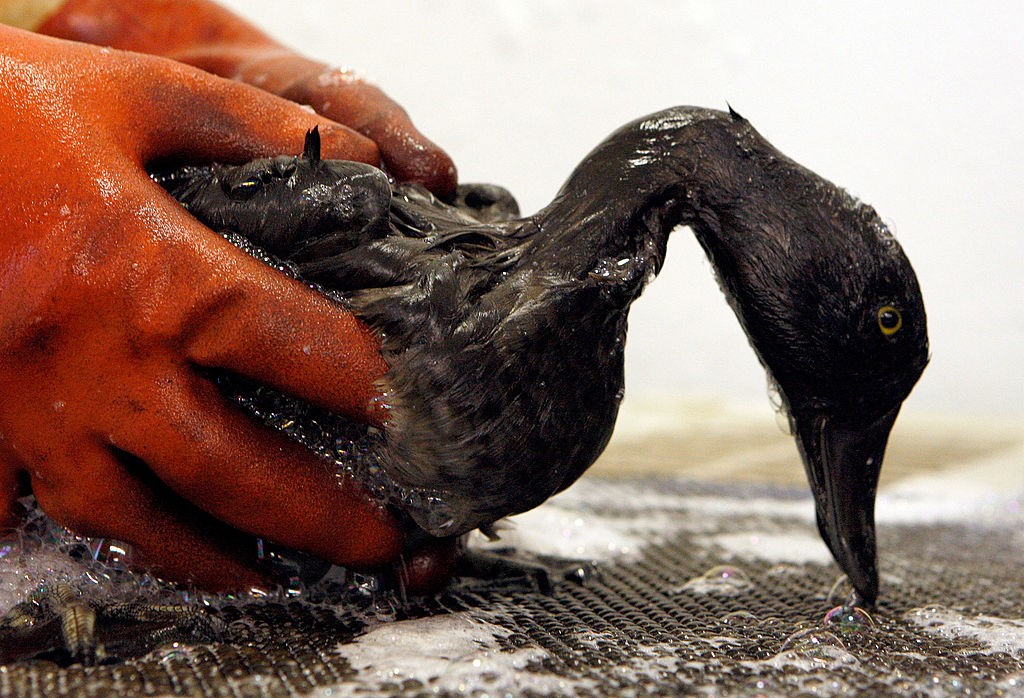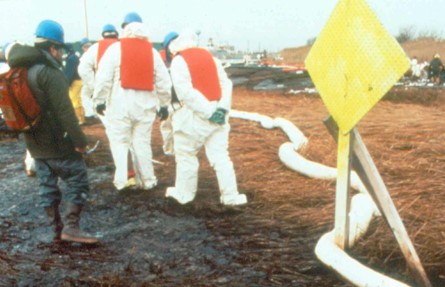June 2, 2020
DEP Snapshot: It’s 1990,
Oil Spill in Arthur Kill Waterway Spoils the Start of a New Year

At a wildlife care center, an oil-soaked bird gets a gentle sudsing as it is cleaned up.And when it spills into waterways, crude oil and petroleum products refined from it coat everything within reach. Hapless birds and other sea animals become covered in the blackish muck, often a life-ending situation.
Oil, according to the National Oceanic and Atmospheric Association, destroys the water repellency of a bird’s feathers and the insulating ability of fur-bearing mammals such as sea otters exposing these creatures to the harsh elements. Unable to repel water and insulate from cold water, birds and mammals can die from hypothermia, NOAA indicates. In addition, exposure to oil’s poisonous chemicals can cause harm internally if they are ingested or inhaled, and externally with skin and eye irritation.
The Exxon Valdez disaster in 1989 and the BP Deepwater Horizon explosion in 2010 proved catastrophic to sea life: Exxon Valdez killed an estimated 250,000 seabirds, 3,000 otters, 300 seals, 250 bald eagles and 22 killer whales; Deepwater Horizon was estimated to have harmed or killed 82,000 birds of 102 species, more than 6,100 sea turtles and up to 25,900 marine mammals, including bottlenose dolphins and sperm whales.
A 1990 spill much closer to home, which spewed home heating oil into the Arthur Kill, never reached such harrowing numbers but claimed more than 700 birds and caused major damage to an urban wilderness area vital to avian creatures.
The impact of the spill, as described by NOAA’s Damage Assessment, Remediation and Restoration Program: The oil blanketed more than two thousand acres of fish and wildlife habitats, including open water, tidal marshes and backwater creeks, and over 200 acres of tidal salt marsh on Staten Island and in New Jersey. The oiling smothered fish, crabs and clams, and caused massive losses of salt marsh cordgrass (Spartina alterniflora) in some wetlands. The oil also directly killed an estimated 700 waterbirds.
A New York Times article published on Jan. 10, 1990, indicated that officials from both New York and New Jersey, have said that Prall’s Island, along Arthur Kill, a 13-mile reach of water, is a vital feeding and nesting area for rare birds on the East Coast…
Environmentalists who have inspected the area have said that the water-proofing ability of black ducks, cormorants and many other bird species which enables them to stay warm has been severely impaired. Birds returning after the winter, they said, would likely find much of their food supply, worms and crabs, wiped out.
And now, a look at 1990 …
On the night of Jan. 1, 1990, an underwater Exxon pipeline ruptured, spilling an estimated 567,000 gallons of home heating oil into the Arthur Kill waterway, which separates New Jersey from Staten Island. It was the largest oil spill in the New York/New Jersey area at the time.

First responders set out oil absorbent pads and a containment boom on Prall’s Island in the days following the 1990 spill.Representatives from the DEP, along with the U.S. Coast Guard and other local and federal agencies, oversaw the cleanup efforts. The following year, DEP researchers also undertook studies to assess the ecological effects of the spill research that helped build a case for a $15 million settlement.
The Exxon Bayway refinery incident was only the first and largest in a spate of spills that occurred in 1990 in the area and came at a time when the country was still reeling from the Exxon Valdez disaster, a mere 10 months earlier. In March 1989, the oil tanker Exxon Valdez ran aground off the coast of Alaska, spilling more than 11 million gallons of crude oil into pristine Prince William Sound.
Exxon Valdez would become known as the worst spill in U.S. history until the Deepwater Horizon Spill in 2010 and would change the way the scientific community viewed and responded to oil spills. In its wake, Congress passed the Oil Pollution Act of 1990, increasing penalties for companies responsible and addressing a wide range of problems associated with preventing and responding to oil pollution incidents.
###